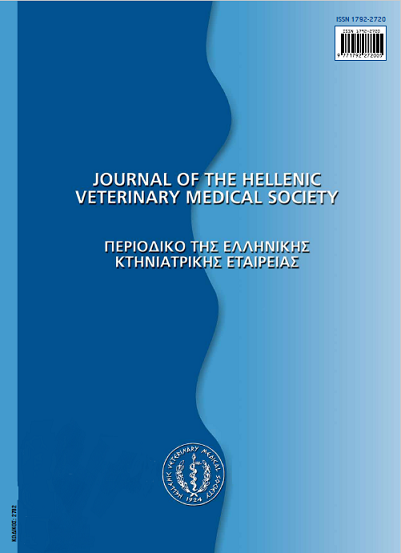Update on syndromes and clinical problems associated with porcine circovirus type 2 infection
Abstract
The porcine circoviruses (PCV) are members of the genus Circovirus, family Circoviridae. Two types of PCV have been characterized and were named Porcine Circovirus type 1/PCVl and Porcine Circovirus type 2/PCV2. PCV1 is considered to be avirulent, since it has never been associated with the occurrence of swine disease. On the contrary, PCV2 is identified as virulent porcine pathogen and the virus is considered to have a potential pathogenic role to Post Weaning Multisystemic Wasting Syndrome (PMWS), Porcine Dermatitis and Nephropathy Syndrome (PDNS) and other porcine diseases, although the pathogenesis of this emerging viral infection has not been yet determined. The association of PCV2 and PMWS is now well established. However, it is believed that co-infection with the Porcine Reproductive and Respiratory Syndrome Virus (PRRSV) is necessary for the clinical expression of the syndrome, while Mycoplasma hyopneumoniae, a common finding in PMWS cases, increases the incidence and the severity of PMWS in pigs. The results of experimental trials indicate that PCV2 may need co-factors and/or a long period of incubation to fully reproduce PMWS, while the stimulation of the immune system after vaccination might be a pivotal event in the production of PMWS. The diagnosis is based on clinical signs, necropsy, on the presence of the characteristic histopathological lesions in lymphoid tissues and the presence of PCV2 (antigens, nucleic acid) within the lesions. PDNS has been reported in several pig-producing countries and is characterized by the presence of hemorrhagic skin lesions, oedema of the limbs, necrotizing vasculitis and glomerulonephritis, affecting pigs of 1.4-4 months old. The demonstration of PCV2 antigens and nucleic acid, closely associated with skin and renal lesions, has led to the speculation that PCV2 is an aetiologic agent of this syndrome. Although PCV2 has been consistendy detected in PDNS, lesions consistent with this syndrome have yet to be reproduced experimentally. It is likely that many factors, such as overcrowding, poor ventilation, commingling of different agegroups, co-infection of viruses and bacteria, and other stressors, may act in a synergistic fashion to trigger as yet unidentified mechanisms to induce PDNS. Porcine Respiratory Disease Complex (PRDC) is a serious health problem in growing and finishing pigs aged around 16-22 weeks. Pneumonia in pigs with PRDC is due to a combination of both viral and bacterial agents, such as PRRSV,swine influenza virus, Mycoplasma hyopneumoniae, Actinobacillus pleuropneumoniae and Pasteurella multocida. Some authors suggest that PCV2 could be an important contributor to PRDC, probably by interaction or synergism with other respiratory pathogens, such as PRRSV. PCV2-associated PRDC should be differentiated from PMWS clinically and histopathologically. There have been several experimental and field reports of PCV2-associated reproductive failure (elevated abortion, stillbirths and fetal mummification). Furthermore, it is suggested that porcine proliferative and necrotising pneumonia is a result of a PRRSV and PCV2 coinfection. Moreover, it has been demonstrated that PCV2 and porcine parvovirus may act as cofactors in the experimental reproduction of exudative epidermitis caused by Staphylococcus hyicus. Thus, it is likely that these viruses are involved in lesion development and/or progression of the disease. Respectively, the results of a recent survey indicate that both viruses are highly prevalent in pigs with exudative epidermitis. Additionally, PCV2 is associated with granulomatous enteritis, congenital tremor and lately with necrotizing lemphadenitis, which might be also manifestations of PCV2 infection. It has recendy been hypothesized that different types of PCV2 may be responsible for different disease manifestations. Most of the relevant studies have found minor differences in the respective PCV2 genomes, but at this time remains unclear what significance these minor differences may have. It has been suggested that they may account for different in tropism with respect to the host organism. In addition, other host factors, such as age or route of infection, may affect the pathogenicity and clinical manifestation of PCV2 infection. However, the pathogenical role of PCV2 remains unclear and further studies are therefore needed to define it. The presence of PDNS, PMWS and for the first time the occurrence of PMWS after vaccination against enzootic pneumonia, and the relationship between PMWS-PRRS and PMWS-PRDC as well, have already been described and diagnosed in Greece. Additionally, the genetic analysis of the first PCV2 isolates from pigs presenting various clinical conditions in Greece has been performed.
Article Details
- Come citare
-
TZIKA (Ε. Δ. ΤΖΗΚΑ) E. D. (2017). Update on syndromes and clinical problems associated with porcine circovirus type 2 infection. Journal of the Hellenic Veterinary Medical Society, 56(3), 256–268. https://doi.org/10.12681/jhvms.15086
- Fascicolo
- V. 56 N. 3 (2005)
- Sezione
- Review Articles
Authors who publish with this journal agree to the following terms:
· Authors retain copyright and grant the journal right of first publication with the work simultaneously licensed under a Creative Commons Attribution Non-Commercial License that allows others to share the work with an acknowledgement of the work's authorship and initial publication in this journal.
· Authors are able to enter into separate, additional contractual arrangements for the non-exclusive distribution of the journal's published version of the work (e.g. post it to an institutional repository or publish it in a book), with an acknowledgement of its initial publication in this journal.
· Authors are permitted and encouraged to post their work online (preferably in institutional repositories or on their website) prior to and during the submission process, as it can lead to productive exchanges, as well as earlier and greater citation of published work.







